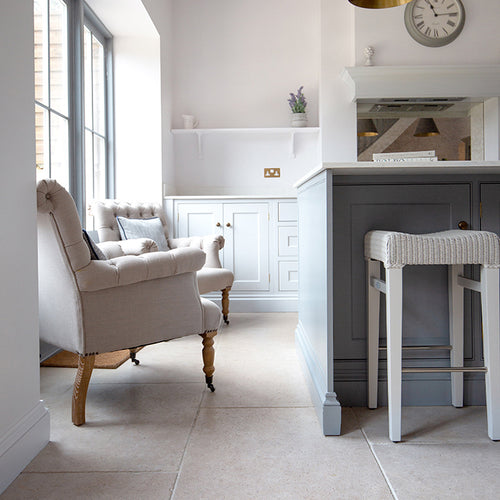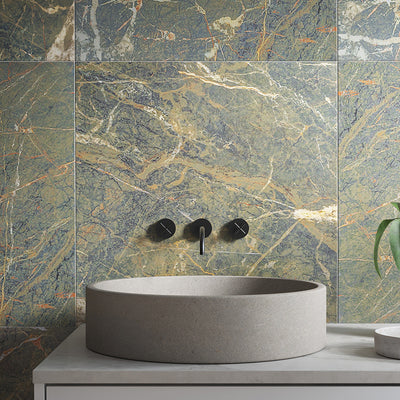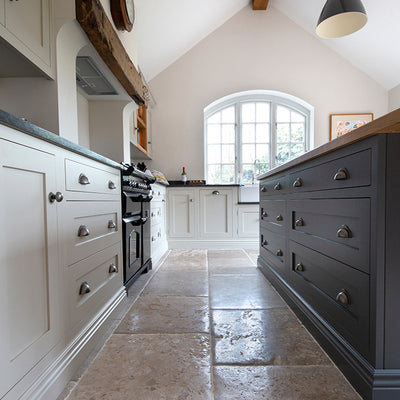Your natural stone floor is newly installed and is looking as beautiful as you hoped. Now, you want to know how to clean natural stone tiles and look after your stone tiles so that they will look their best for year to come. A wonderful feature of natural stone is its forgiving nature, thanks to natural markings, fossils and tonal variation from tile to tile – so many of our customers are amazed at how great natural stone is at disguising day to day dirt! Whilst many may worry that it is hard to clean and look after natural stone tiles, we have a few helpful tips to keep things simple and make certain your natural stone floor is well-maintained and cared for.
Quorn Stone’s Quick Guide
1. Use a cleaner suitable for natural stone
2. Vacuum or sweep regularly with soft brush attachments
3. Occasional mopping
4. Re-seal the tiles when necessary
5. Spot clean spillages
6. Be prepared with Power Clean
What not to do
1. Avoid using harsh cleaners such as bleach and commercial bathroom products
2. Avoid leaving spillages on the surface of the stone for long periods of time (especially acidic substances such as red wine, coffee and lemon juice)
3. Avoid scrubbing with anything overly abrasive or a detergent that has abrasives in
4. Avoid using vacuum cleaners with any rough or broken surfaces on the plastic attachments or wheels
1. Use a cleaner suitable for natural stone
First and foremost ensure you use a cleaner suitable for natural stone. Natural stone is any stone that is quarried from the earth such as limestone, sandstone and marble. These natural materials should not be cleaned with any harsh or commercial cleaners such as bleach – acidic cleaners will eat away at the sealant and eventually damage the stone. We recommend finding a pH neutral cleaner, such as Lithofin Wash & Clean, diluted in warm water. This product is made for natural stone and will help clean, enhance, and maintain the natural surface of your tiles. Some cleaners may say ‘suitable for natural stone’. When trying any new cleaner, we always suggest doing a patch test in an inconspicuous area of the floor to be safe.
2. Vacuum or sweep regularly with soft brush attachments
For daily maintenance and cleaning natural stone tiles, we advise sweeping and vacuuming with a soft brush attachment. This is very effective at removing any dirt or dust off the surface of your stone floor. It is important to only vacuum or sweep when mud or dirt is dry, doing so on wet or fresh mud runs the risk of spreading the dirt across and into the grout. A wonderful feature of natural stone is its forgiving nature, thanks to natural details, fossils, and variation from tile to tile – so many of our customers are amazed at how great natural stone is at disguising day to day dirt!
3. Occasional mopping
Following regular vacuuming and sweeping, we do also recommend a deeper clean with occasional mopping. Ensuring you use a pH neutral floor cleaner made for natural stone (as mentioned above) and that the floor is clear of any excess mud, dirt or dust, will help clean and maintain your natural stone floor over the years. With mopping, less is often more! We recommend keeping this to a minimum. Excessive mopping will wear away at the sealant sooner and is more likely to cause grout to discolour over time. We advise against using a steam cleaner on natural stone as this will affect the longevity of the sealant.
4. Re-seal the tiles when necessary
Upon installation, sealing your tiles is a crucial step to help keep natural stone tiles clean and protected. The sealant acts as a protective barrier against water and stains. We recommend Lithofin Stain Stop which is a matte sealant that will not darken the colour of your tiles. For most indoor spaces such as kitchens, ground floors and hallways, resealing should be done every 4-6 years. For bathrooms or areas with high moisture levels, resealing may be needed more often. A great way to test if your floor needs resealing is to drop a little water onto the surface. If the sealant is still effective, the water will bead on the surface, if water soaks straight into the tiles, this is usually a sign that your natural stone floor needs resealing. Resealing is a very simple job that you can do yourself.
5. Spot clean spillages
Whilst sealant can protect natural stone against many day-to-day spills, it cannot protect against harsh chemicals or acidic spills. This includes things like wine, orange juice, lemon, coffee and puppy accidents! The best way to keep your natural stone floor at its best is to spot clean any spillages as soon as they happen, just as you would with any other flooring covering. Spot cleaning can be simply done with a cloth and warm water, ensuring all trace of the spillage is gone. Remember, the quicker a spillage is cleaned up, the less likely it is to leave a mark.
6. Be prepared for stains with Power Clean
Once natural stone is sealed, it is fairly resistant to staining. With the odd occasion where stains may occur from a mishap, we advise having a bottle of Lithofin Power Clean at the ready in your cupboard. This stone friendly cleaner can be used neat on a stain or diluted in warm water to clean your entire floor and is a great, powerful product to remove those unexpected stains.

FAQ's on cleaning natural stone tiles
Are natural stone tiles hard to keep clean?
No! Following our few simple key steps noted above, natural stone tiles are very easy to look after and clean. Many have a misconception of natural stone not being up to the job for kitchens tiles and ground floors, but so many of our customers are always amazed at how hardwearing and forgiving natural stone is with the correct care.
Can I use bleach to clean natural stone tiles?
We strongly advise against using bleach or any harsh chemicals to clean your stone floor tiles. Instead, make sure you use a pH neutral cleaner or a stone-friendly cleaner (that says it is suitable for natural stone).
How can I get rid of stains on natural stone tiles?
The best way to avoid staining is to spot clean as soon as a spillage occurs! On the occasion that a stain does occur on your natural stone floor, we recommend trying Lithofin Power Clean. This stone friendly cleaner can be used neat on a stain or diluted in warm water to clean your entire floor and is a great, powerful product to remove those unexpected stains!
How often should I reseal natural stone tiles?
As mentioned in the post, for most indoor spaces such as kitchens, ground floors and hallways, resealing should be done every 3-5 years. For bathrooms or areas with high moisture levels, resealing may be needed more often. A great way to test if your floor needs resealing is to drop a little water onto the surface. If the sealant is still effective, the water will bead on the surface, if water soaks straight into the tiles, this is usually a sign that your natural stone floor needs resealing. Resealing is a very simple job that you can do yourself.
How do I polish natural stone tiles?
Generally, our natural stone tile range consists of tumbled or more rustic and matt finished stone, however polishing the surface of natural stone tiles is something that can be done. You can use a treatment such as Lithofin Multi Seal or Lithofin Cobble Wax to add a sheen to the surface, which will also slightly enrich the colour of your natural stone tiles.






